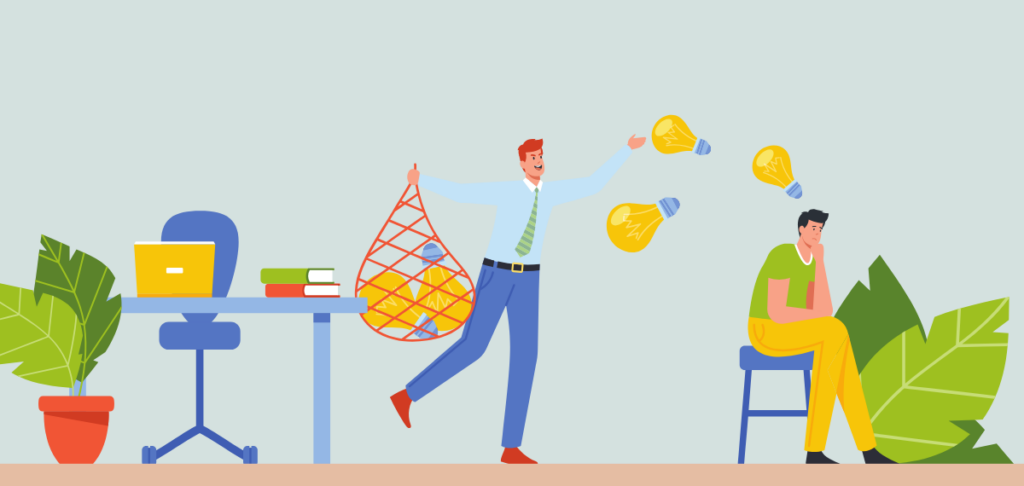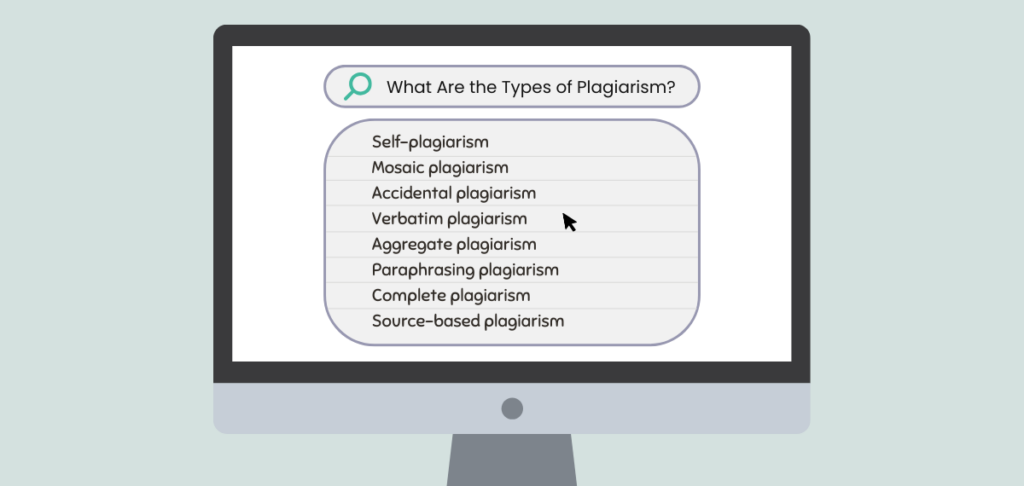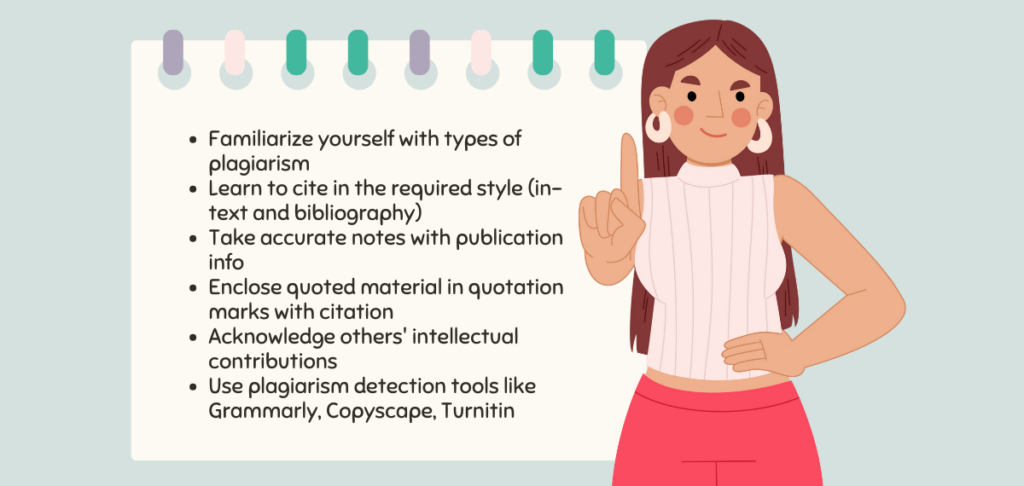Plagiarism is defined as presenting ideas or work from another source as your own, usually without the author’s consent and without full acknowledgment.
Plagiarism is a critical issue in academic and professional environments as it undermines scholarship and research integrity. If an author presents someone else’s work as theirs, they’re basically stealing ideas and claiming credit for work they didn’t do. In these sectors, originality, honesty, and ethics are highly valued, and plagiarism contradicts all these principles.
In this guide, I’ll explore the history of plagiarism, covering its legal and ethical aspects. I’ll also discuss various forms of plagiarism, why it’s significant, and the reasons to avoid it. Additionally, I offer the most notable, real-world examples of plagiarism and share practical tips to help you avoid it inadvertently.
Let’s get to it!

What Is the History of Plagiarism?
The word plagiarism originates from the Latin word plagiarius, which literally means a kidnapper who traps children or slaves in a net or plaga.
In AD 40–102, the Roman poet Martial was the first to apply the word plagiarius to a person who used his literary works and claimed them as their own. So, that’s assumed to be the earliest recorded case of plagiarism in literature.
It’s unclear when the word plagiarism was first used in the English language. However, it’s thought to have happened around 1601, when, at that time, satirist and author Ben Jonson used the word plagiary to describe literary theft.
What Are Legal Considerations of Plagiarism?
There are legal implications of plagiarizing someone else’s work. In this section, I reveal the consequences of literary burglary.
Legal Framework
The legal framework surrounding plagiarism is complex and varies depending on the context and country.
Essentially, original works are protected by copyright laws from being copied or used without the author’s permission.
In the US, the Copyright Act of 1976 is the primary law guarding against plagiarism and providing legal remedies for copyright owners whose work is stolen. Similarly, in the United Kingdom, the Copyright, Designs and Patents Act 1988 protects copyright.
Plagiarism is a serious offense in academia, and some educational institutions have their own policies and regulations that deal with plagiarism internally.
Legal Consequences
Since plagiarism is illegal and unethical, offenders could face several legal consequences if they’re caught plagiarizing someone’s work.
In severe cases, the guilty party could face a lawsuit filed by the original author of the stolen work. The author can claim damages for financial losses, sometimes resulting in significant amounts of compensation.
In addition, penalties, including fines, suspension, or expulsion from educational institutions, can result. Some cases see plagiarists losing their jobs and being blackballed from future employment opportunities. That damaged reputation could have a long-lasting effect on the plagiarist’s personal and professional life.
Some countries regard plagiarism as a criminal offense, and severe penalties, including imprisonment, could be imposed on offenders.
Notable Cases
Some notable examples of plagiarism cases include the following:
- In 1978, in Alex Haley vs. Harold Courlander, Alex Haley, the author of Roots, faced accusations of plagiarism by Harold Courlander, who claimed that Haley copied parts of his novel The African. The case was settled out of court, with Haley acknowledging similarities and paying an undisclosed financial settlement.
- In the case of George Harrison vs. Bright Tunes Music Corp (1976), the lead guitarist of The Beatles, George Harrison, was sued for plagiarism in the song “My Sweet Lord.” The court found that Harrison subconsciously copied the melody from the Chiffons’ song “He’s So Fine.”
- J.K. Rowling vs. Steven Vander Ark (2008). J.K. Rowling, the author of the Harry Potter series, sued a fan and his publisher over a planned Harry Potter encyclopedia. The court ruled in Rowling’s favor, stating that the proposed book copied too much from the original works.
What Are the Ethical Implications?
Plagiarism significantly impacts original authors, the academic community, and the integrity of research and publications.
Original authors lose recognition for their work, and trust is eroded, potentially affecting their career and willingness to collaborate with other students or authors. In the academic community, plagiarism compromises the quality of research, undermines credibility, and considerably reduces the value of papers and other publications.
What Are the Forms/Types of Plagiarism?

There are eight types of plagiarism, including the following:
- Self-plagiarism
- Mosaic plagiarism
- Accidental plagiarism
- Verbatim plagiarism
- Aggregate plagiarism
- Paraphrasing plagiarism
- Complete plagiarism
- Source-based plagiarism
Self-Plagiarism
This form of plagiarism means presenting your previously submitted work as new or original. Self-plagiarism is sometimes called spinning when the text has been reformatted or slightly reworded to make it look new.
Mosaic Plagiarism
Mosaic plagiarism, also called patchwriting, means copying and pasting text from multiple sources and combining it into a new document without proper citation or acknowledgment of the original author. The idea is to create what appears to be an original piece when it is not.
Accidental Plagiarism
Accidental plagiarism occurs when you inadvertently use someone’s work without crediting or citing the source. It can also happen when you don’t understand the proper citation format or simply don’t realize that the information being used is not common knowledge.
Verbatim Plagiarism
As you might guess from its name, verbatim plagiarism means copying someone else’s work word-for-word without acknowledging the original source.
Aggregate Plagiarism
Aggregate plagiarism happens when you combine ideas or information from multiple sources to create a new piece of work without citing the originals.
This is similar to mosaic plagiarism, but instead of physically copying and pasting the original text, you take ideas and information from many different sources.
Paraphrasing Plagiarism
You commit paraphrasing plagiarism when you rephrase someone else’s work and present it as your own without citing the original author.
Complete Plagiarism
Complete plagiarism is similar to verbatim plagiarism. This happens when you submit someone else’s work as your own without proper citation or acknowledgment.
Source-Based Plagiarism
When you use information from a single source without correct citation, you commit source-based plagiarism. That often occurs when you rely too heavily on one reference source or don’t properly credit the source from which the information was obtained.
Why Does Plagiarism Matter?
Plagiarism is a serious matter because it compromises academic integrity by falsely attributing the work and ideas of others. This unethical act violates copyright laws and can result in serious legal action. Also, it tarnishes the reputation of both the individual responsible and the institution they are affiliated with.
Why Should You Avoid Plagiarism?
Avoiding plagiarism upholds academic integrity, honors the intellectual efforts of others, and upholds the trustworthiness of research and information. Moreover, dodging plagiarism safeguards against potential legal and ethical repercussions for appropriating others’ work.
How to Avoid Plagiarism

Here are some helpful tips to help you avoid plagiarism:
- Familiarize yourself with the different types of plagiarism to understand what not to do.
- Understand how to cite sources in the style required by your academic or professional institution, both in-text and bibliography/reference list formats.
- Make accurate notes while writing, including the source’s publication information. This will make it easier to use correct citations and prevent accidental plagiarism.
- If quoting verbatim from a source, enclose the quoted material in quotation marks and provide a correct citation.
- Acknowledge the intellectual contributions of others, including credit for ideas, data, and concepts.
- Use plagiarism detection tools like Grammarly, Copyscape, and Turnitin to check your work for unintentional plagiarism.
What Plagiarism-Checking Tools Can I Use?
There are several educational tools and software designed to detect and prevent plagiarism. Some of these include:
- Grammarly
- Copyscape
- Turnitin
- Plagtracker
- Duplichecker
- Viper
- Quetexgt
Even if you don’t intentionally copy someone else’s work, you could accidentally use a few very similar phrases, sentences, or paragraphs that could be interpreted as plagiarized. I always run my copy through two of the above tools, just to be sure before I submit my work!
FAQs
Here are the answers to a few of the most commonly asked questions about plagiarism.
Yes! Failing to attribute the original author when paraphrasing reference material constitutes plagiarism, as it involves presenting another person’s ideas as your own. Conversely, proper citation of the source prevents plagiarism when paraphrasing. content.
Ideally, yes! Citing each claim enhances the credibility of your document by substantiating the information presented. Over-citation is preferable to under-citation, as it ensures thoroughness and reliability in your writing or academic work.
No, avoiding sources altogether isn’t the solution. Utilizing reputable references elevates the credibility of your writing. To sidestep unintentional plagiarism, diversify your sources and steer clear of the following pitfalls:
- Overdependence on a couple of sources
- Excessive direct quotations
- Paraphrasing too closely to the original text
Conclusion
Plagiarism means stealing someone else’s work and passing it off as your own. That goes against ethical standards, undermines the writer’s credibility, and is illegal.
In most countries, copyright laws protect authors against plagiarism, and contravening them can result in heavy fines, lost jobs, and even imprisonment in some jurisdictions.
There are eight main types of plagiarism, all of which can greatly impact original authors, the integrity of publications and research, and the academic community. It’s essential to be aware of unintentional plagiarism, as that can take you by surprise if you use too many citations from the same source or paraphrase someone else’s work too often.
